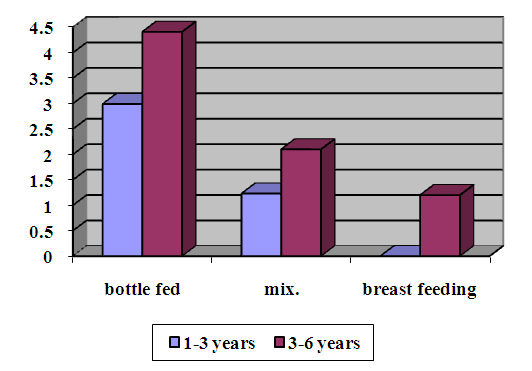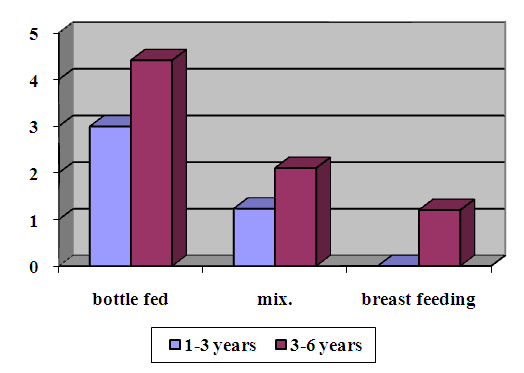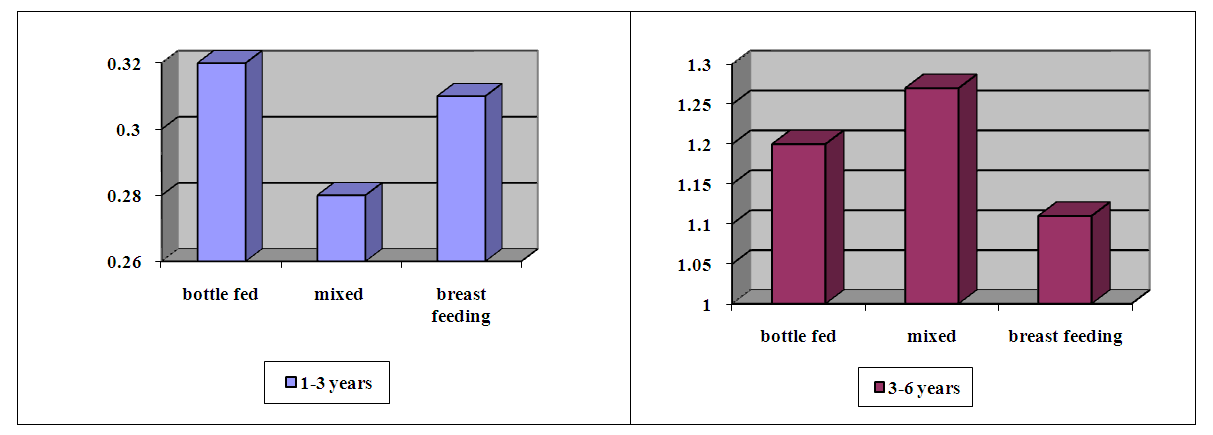-
Paper Information
- Next Paper
- Previous Paper
- Paper Submission
-
Journal Information
- About This Journal
- Editorial Board
- Current Issue
- Archive
- Author Guidelines
- Contact Us
American Journal of Medicine and Medical Sciences
p-ISSN: 2165-901X e-ISSN: 2165-9036
2024; 14(3): 679-681
doi:10.5923/j.ajmms.20241403.30
Received: Feb. 12, 2024; Accepted: Mar. 6, 2024; Published: Mar. 9, 2024

Dental Status of Children Depending on the Type of Feeding
S. S. Murtazaev, F. R. Jalilova
Tashkent State Dental Institute, RUDN University, Uzbekistan
Correspondence to: S. S. Murtazaev, Tashkent State Dental Institute, RUDN University, Uzbekistan.
| Email: |  |
Copyright © 2024 The Author(s). Published by Scientific & Academic Publishing.
This work is licensed under the Creative Commons Attribution International License (CC BY).
http://creativecommons.org/licenses/by/4.0/

Considering the type of feeding, a dental examination of the oral cavity was carried out in 123 children aged 1 - 6 years. observations confirm the data on the high prevalence of dental caries, 8 times more often among children who were bottle-fed. Their CP (The process capability) index is 6 times higher than that of children who were breastfed. The high prevalence of caries in young children is not due to unsatisfactory hygienic condition of the oral cavity.
Keywords: Dental status, Early childhood caries, Intensity of caries, Hygienic condition of the oral cavity
Cite this paper: S. S. Murtazaev, F. R. Jalilova, Dental Status of Children Depending on the Type of Feeding, American Journal of Medicine and Medical Sciences, Vol. 14 No. 3, 2024, pp. 679-681. doi: 10.5923/j.ajmms.20241403.30.
Article Outline
1. Introduction
- Dental caries is the most common dental disease in children in most countries of the world. Improving and searching for effective and affordable ways to prevent dental caries, especially in childhood, remains relevant today [3,7,9,10].Early childhood caries is a prerequisite for public health. A problem that is one of the most global problems of childhood diseases. According to the American Academy of Pediatric Dentistry, compared to other childhood diseases, the rate of early childhood tooth decay is five times the cause of seizures and seven times the rate of hay fever [1].The consequences of Early childhood caries on the health and quality of life of the child are numerous and severe: increased risk of malocclusion and the development of new caries in the mixed and permanent dentition; increased episodes of pain and dental emergencies; risk of bacteremia; changes in child development and growth are possible; learning difficulties with reduced academic performance [5,7].The most important link in the prevention of major dental diseases is hygienic education of the population, dental educational work and training in the rules of oral hygiene. In this regard, comprehensive dental caries prevention programs are being developed and implemented at the state level, aimed at certain categories of the population: school students, industrial workers, pregnant women. Among the latter, the prevention of caries is the most relevant, since it is aimed at correcting the dental status of a woman and implementing antenatal prevention of caries in the unborn child.A healthy diet in early childhood is essential to supporting optimal growth and development and preventing chronic diet related diseases. Experts across health care disciplines recognize the importance of breastfeeding during infancy [1]. The especially recognizes the importance of and supports: • breastfeeding of infants prior to 12 months of age to ensure the best possible health and developmental and psychosocial outcomes for infants [1,8].Breast-feeding beyond six months old seems to reduce the risk of early childhood caries in early years of life [3,4,5].A systematic review of cariogenic potential of milk and infant formulas in animal models found that cow’s milk and human milk are less cariogenic than sucrose solutions [1,3].Group prevention programs are the most accessible, cost-effective and effective means of prevention [2,4,8].Still limited data from representative surveys are available on the prevalence of Early Childhood Caries (ECC; i.e., the presence of one or more decayed, missing, or filled tooth surfaces in any primary tooth in a child aged 71 months or younger), particularly for infant. We conducted a survey in Italian children aged 0 to 71 months [2].
2. Aim of the Study
- To study the dental status of formula-fed children.
3. Materials and Methods
- According to the type of feeding on which children were in the first years of their lives, a dental examination of the oral cavity was carried out in 123 children aged 1 to 6 years. The intensity of dental caries was studied using the decay-missing-filled (DMF) index. The hygienic state of the oral cavity was determined according to the index of E.M. Kuzmina (2000), used to assess dental plaque in young children.To assess the amount of dental plaque in a young child (from the eruption of primary teeth to 3 years of age), all teeth present in the oral cavity are examined. The assessment is carried out visually or using a dental probe. The amount of plaque must be determined even if the child has only 2-3 teeth in the oral cavity. Codes and evaluation criteria:0 – no plaque;1- plaque present.The index is calculated using the formula: Dental plaque = number of teeth with plaque / number of teeth in the oral cavity.Index interpretation:hygiene level0 – good;0.1 – 0.4 – satisfactory;0.5 -1.0- bad.
4. Results
- The prevalence of dental caries among bottle-fed children aged 1-3 years was 63.9% and 3-6-year-old children 79.6%; in bottle-fed children this figure was significantly lower and amounted to 5.1% and 12 .8% respectively. The data obtained on the incidence of dental caries in children indicate a significant tendency towards a high incidence of dental caries in children who were bottle-fed. (Fig 1.)
 | Figure 1. Prevalence of dental caries in children depending on the type of feeding |
 | Figure 2. Intensity of dental caries in children depending on the type of feeding |
 | Figure 3. Hygienic condition of the oral cavity in children depending on the type of feeding |
5. Discussion
- Our observations confirm the data on the high prevalence of dental caries, 8 times more often among formula-fed children. Their CP index is 6 times higher than that of children who were breastfed.The oral hygiene index in all age groups, regardless of the type of feeding, indicates its satisfactory condition. The higher incidence of dental caries than in breast-fed children cannot be associated with poor oral hygiene. Although, according to the literature, poor oral hygiene is the leading link in the pathogenesis of caries [9]. Dental care provided to these patients should include not only treatment, but also primary prevention, considering the nature and type of feeding of damage to the hard tissues of the teeth. In this regard, we consider it advisable to pay great attention to further study and identification of etiopathogenetic mechanisms of established disorders and the development of preventive dental measures for this group of children.
6. Conclusions
- In young children, depending on the type of feeding, there is a high intensity and prevalence of dental caries.The high prevalence of caries in young children is not due to unsatisfactory hygienic condition of the oral cavity.The obtained data on the epidemiology of caries and its complications will help develop the necessary measures for the treatment and prevention of caries among children who were bottle-fed.
 Abstract
Abstract Reference
Reference Full-Text PDF
Full-Text PDF Full-text HTML
Full-text HTML